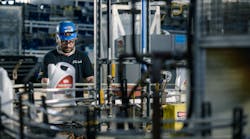Plastipak Packaging
Manufacturer of plastic containers and packaging products
Plymouth, MI
4,000 employees | 20 sites | 3 EHS professionals
Where safety sits in an organization can impact its effectiveness. At Plastipak Packaging, safety is “owned” by operations, not the EHS function. “It is an integral part of every performance review for every associate in the company, including leadership,” explains Andrew Smigiel, the company’s EHS manager, North America.
Moving into everyday operations can create a new process. “Our overall philosophy is to learn and improve to prevent recurrence or add capacity to our system, not the traditional approach of ‘blame and punish’ to achieve zero accidents,” Smigiel explains. “We have adopted and incorporated the Human and Organization Performance (HOP) principles into our program and want to learn how work is actually accomplished, versus how the standard says it should be done.”
Part of the human approach is to view an employee holistically. “We openly discuss psychological safety with the leadership teams at our sites,” says Smigiel. “We think the best report card we have is nearly 29,000 annually documented safety engagements, which are split roughly 50/50 between reported near misses and safety conversations. Our safety conversations include affirmation of safe work practices as well as corrective discussions amongst peers for minor issues. This process is clearly the ‘voice of the employees’ telling us what is happening, or not happening, on the production floor.”
Understanding the needs of employees is further demonstrated by an unusual practice at the company. New associates are provided a different color helmet than the company’s standard blue one, which readily identifies them to others who can pay special attention to help them as they become more familiar with processes and the associated hazards. When a new associate completes their orientation period, the company has a recognition ceremony to award them a blue helmet.
And of course, communication is always the cornerstone of safety. At Plastipak every two weeks the site has an all-employee meeting for each of its four shifts. Led by the site manager and local site leadership team, safety is the first thing on the agenda and includes discussing new initiatives and corrective actions from incidents. “Many times these messages are cascaded from the weekly EHS Incident Review calls with our site leadership teams,” notes Smigiel.
And safety is personal. Each year, the site manager meets with every employee in a one-on-one setting to have a dialogue focused solely on safety. There is a specific discussion on empowering employees to stop any unsafe job/operation as well as encouraging employees to approach others if they see something that is unsafe. The site manager also reviews the company’s “Safety Top 10” during this discussion and they sign a “Safety Commitment Letter.”
“These are analogous to the Ten Commandments and focus on key risks that must be addressed in our plants,” says Smigiel.

